Hinokitiol

Hinokitiol structure
|
Common Name | Hinokitiol | ||
|---|---|---|---|---|
| CAS Number | 499-44-5 | Molecular Weight | 164.201 | |
| Density | 1.1±0.1 g/cm3 | Boiling Point | 303.4±35.0 °C at 760 mmHg | |
| Molecular Formula | C10H12O2 | Melting Point | 50-52 °C(lit.) | |
| MSDS | Chinese USA | Flash Point | 128.1±18.5 °C | |
| Symbol |

GHS07 |
Signal Word | Warning | |
Use of HinokitiolHinokitiol is a component of essential oils isolated from Chymacyparis obtusa, reduces Nrf2 expression, and decreases DNMT1 and UHRF1 mRNA and protein expression, with anti-infective, anti-oxidative, and anti-tumor activities. |
| Name | β-thujaplicin |
|---|---|
| Synonym | More Synonyms |
| Description | Hinokitiol is a component of essential oils isolated from Chymacyparis obtusa, reduces Nrf2 expression, and decreases DNMT1 and UHRF1 mRNA and protein expression, with anti-infective, anti-oxidative, and anti-tumor activities. |
|---|---|
| Related Catalog | |
| Target |
DNMT1 Nrf2 |
| In Vitro | In U87MG and T98G glioma cell lines, hinokitiol demonstrates a dose-dependent decrease in viability, with IC50 values of 316.5 ± 35.5 and 152.5 ± 25.3 µM, respectively. Hinokitiol represses ALDH activity and self-renewal ability in glioma stem cells, and inhibits in vitro oncogenicity. Hinokitiol also reduces Nrf2 expression in glioma stem cells in a dose-dependent manner[1]. Hinokitiol (0-100 μM) inhibits colon cancer cell growth in a dose- and time-dependent manner. Hinokitiol (5, 10 μM) decreases DNMT1 and UHRF1 mRNA and protein expression, and increases TET1 expression via enhancement of 5hmC level in HCT-116 cells. Furthermore, hinokitiol reduces methylation status and restores mRNA expression of MGMT, CHST10, and BTG4 genes[2]. |
| Cell Assay | U87MG and T98G glioma cells are cultured in Dulbecco's modified Eagle's medium with Ham's F12 medium (DMEM/F-12) containing 10% fetal bovine serum. Cell viability is determined using MTT to evaluate the cytotoxicity of hinokitiol. Cells are seeded in 24-well plates (1×105 cells/well) in the presence of various concentration of hinokitiol or vehicle at 37°C for 24 h followed by incubation with MTT reagent. The blue formazan crystals of viable cells are dissolved in DMSO and then evaluated spectrophotometrically at 570 nm. DMSO-treated group is set as 100%, and data are presented as percentage of DMSO control. IC50 values are calculated by the GraFit software. |
| References |
| Density | 1.1±0.1 g/cm3 |
|---|---|
| Boiling Point | 303.4±35.0 °C at 760 mmHg |
| Melting Point | 50-52 °C(lit.) |
| Molecular Formula | C10H12O2 |
| Molecular Weight | 164.201 |
| Flash Point | 128.1±18.5 °C |
| Exact Mass | 164.083725 |
| PSA | 37.30000 |
| LogP | 1.89 |
| Vapour Pressure | 0.0±1.4 mmHg at 25°C |
| Index of Refraction | 1.554 |
CHEMICAL IDENTIFICATION
HEALTH HAZARD DATAACUTE TOXICITY DATA
|
| Symbol |

GHS07 |
|---|---|
| Signal Word | Warning |
| Hazard Statements | H302 |
| Personal Protective Equipment | dust mask type N95 (US);Eyeshields;Gloves |
| Hazard Codes | Xn:Harmful; |
| Risk Phrases | R22 |
| Safety Phrases | S36 |
| RIDADR | NONH for all modes of transport |
| WGK Germany | 3 |
| RTECS | GU4200000 |
| HS Code | 2914400090 |
| Precursor 8 | |
|---|---|
| DownStream 9 | |
| HS Code | 2914400090 |
|---|---|
| Summary | 2914400090 other ketone-alcohols and ketone-aldehydes。Supervision conditions:None。VAT:17.0%。Tax rebate rate:9.0%。MFN tariff:5.5%。General tariff:30.0% |
|
Determination of hinokitiol in skin lotion by high-performance liquid chromatography-ultraviolet detection after precolumn derivatization with 4-fluoro-7-nitro-2,1,3-benzoxadiazole.
J. Cosmet. Sci. 64(5) , 381-9, (2013) Hinokitiol, a potent, broad-spectrum antibacterial agent, is a component of various personal care products. In this study, the concentration of hinokitiol in skin lotion was analyzed by means of high-... |
|
|
The furan route to tropolones: probing the antiproliferative effects of β-thujaplicin analogs.
Org. Biomol. Chem. 10(43) , 8597-604, (2012) A direct route to analogs of the naturally occurring tropolone β-thujaplicin has been developed in just four steps from furan. Using this method, a series of derivatives were synthesized and evaluated... |
|
|
High-performance liquid chromatography with dual-wavelength ultraviolet detection for measurement of hinokitiol in personal care products.
J. Cosmet. Sci. 60(5) , 519-25, (2009) Hinokitiol is found in the heartwood of several cupressaceous plants and is frequently added to cosmetic products such as hair restorers, skin lotions, and body soaps because of its potent and broad-s... |
| Isopropyltropolone |
| 2-Hydroxy-6-(propan-2-yl)cyclohepta-2,4,6-trien-1-one |
| B-THUJAPLICIN |
| 2,4,6-cycloheptatrien-1-one, 2-hydroxy-6-(1-methylethyl)- |
| 2-Hydroxy-6-(propan-2-yl)cyclohepta-2,4,6-trien-1-on |
| beta-thujaplicin |
| 4-ISOPROPYLTROPOLONE |
| MFCD00040180 |
| 2-Hydroxy-4-isopropylcyclohepta-2,4,6-trien-1-one |
| 2,4,6-Cycloheptatrien-1-one, 2-hydroxy-4-(1-methylethyl)- |
| β-Thujaplicine |
| EINECS 207-880-7 |
| Hinokitiol |
| β-Thujaplicin |
| Hinokitol |
| 2-Hydroxy-4-isopropyl-2,4,6-cycloheptatrien-1-one |
| 2-hydroxy-4-(1-methylethyl)-2,4,6-cycloheptatrien-1-one |
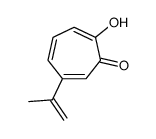 CAS#:4570-11-0
CAS#:4570-11-0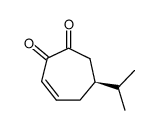 CAS#:310905-95-4
CAS#:310905-95-4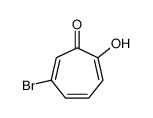 CAS#:698-47-5
CAS#:698-47-5 CAS#:55076-49-8
CAS#:55076-49-8 CAS#:108168-72-5
CAS#:108168-72-5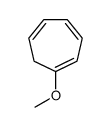 CAS#:1728-32-1
CAS#:1728-32-1 CAS#:1714-40-5
CAS#:1714-40-5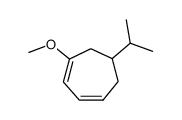 CAS#:133826-10-5
CAS#:133826-10-5 CAS#:931-88-4
CAS#:931-88-4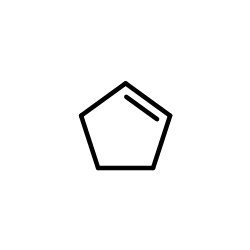 CAS#:142-29-0
CAS#:142-29-0 CAS#:79-31-2
CAS#:79-31-2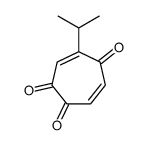 CAS#:88088-40-8
CAS#:88088-40-8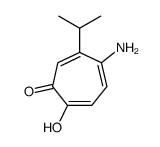 CAS#:90035-67-9
CAS#:90035-67-9 CAS#:92832-19-4
CAS#:92832-19-4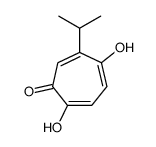 CAS#:54755-56-5
CAS#:54755-56-5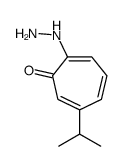 CAS#:55438-27-2
CAS#:55438-27-2
